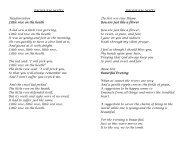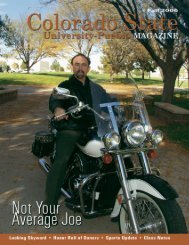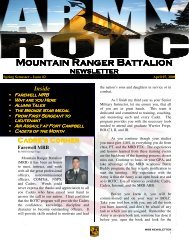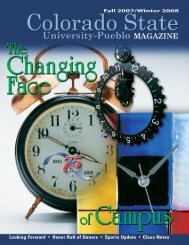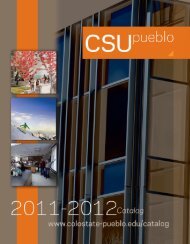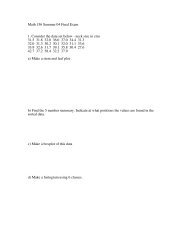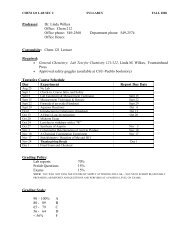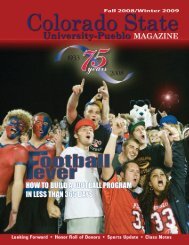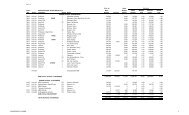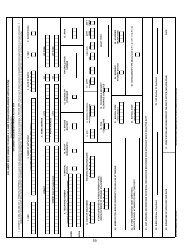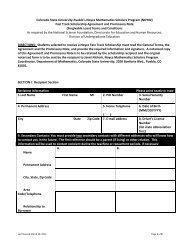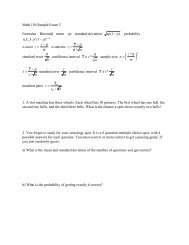2007-2008 Catalog (PDF) - Colorado State University-Pueblo
2007-2008 Catalog (PDF) - Colorado State University-Pueblo
2007-2008 Catalog (PDF) - Colorado State University-Pueblo
Create successful ePaper yourself
Turn your PDF publications into a flip-book with our unique Google optimized e-Paper software.
Academic Policies<br />
Failure to submit Appeal Letters within this prescribed<br />
time line will result in academic suspension for two<br />
consecutive semesters (excluding summer).<br />
CLASS HOURS AND CREDIT HOURS<br />
A class hour consists of 50 minutes. One class hour<br />
per week of lecture or discussion for a semester earns<br />
a maximum of one credit hour. Two or three class<br />
hours a week of laboratory activities for a semester<br />
earn a maximum of one credit hour. The number of<br />
credits awarded for a given course is determined by<br />
the number of lecture or laboratory hours spent each<br />
week in class and is authorized in accordance with<br />
guidelines of the <strong>Colorado</strong> Commission on Higher<br />
Education.<br />
POLICY ON AWARD OF CREDIT<br />
Instructional activity is broadly categorized into three<br />
categories: Type A, Type B and Type C by the<br />
<strong>Colorado</strong> Commission on Higher Education (CCHE) as<br />
published in its Policy for Reporting Full-time Equivalent<br />
Students.<br />
1) Type A Instruction<br />
Type A instruction is defined as consisting of<br />
“those methods in which the consumption of<br />
faculty resources is reasonably concrete and<br />
measurable.” In these instances, the criteria are<br />
established in terms of a faculty Base Contact<br />
Hour. The Base Contact Hour is a minimum of 750<br />
minutes (this translates into a 50 minute period for<br />
15 times). Type A instructional activities are audit;<br />
private instruction; lecture; recitation, discussion,<br />
and seminar; laboratory (vocational and technical;<br />
academic and clinical); physical education and<br />
recreation activity courses; studio (art and music)<br />
and field instruction.<br />
2) Type B Instruction<br />
Type B instruction is defined as consisting of<br />
“those methods where the measurement of faculty<br />
resource consumption by students is less<br />
definitive and will vary depending on the activity.<br />
The activities occurring in these areas are,<br />
therefore, defined in a “contractual relationship”<br />
between faculty and students.” Examples of Type<br />
B instruction are independent study/special or<br />
independent project; Master’s thesis research<br />
project and practicum, student teaching, internship,<br />
and cooperative education.<br />
3) Alternative Delivery Methods<br />
These are courses delivered in non-traditional<br />
formats, including but not limited to, telecourses,<br />
self-paced instruction assisted by educational<br />
technologies, interactive video, telephone lines,<br />
computer based or computer assisted instruction,<br />
correspondence, videotapes or CD-Rom, Internet<br />
or Intranet, multimedia, etc... The credit hours for<br />
courses utilizing these alternative delivery<br />
methods shall be assigned based upon the<br />
equivalency or similarity of the course content’s<br />
scope and depth and the course’s evaluation<br />
methods to the same or similar courses currently<br />
offered at CSU-<strong>Pueblo</strong>. Lecture courses delivered<br />
on-campus and also delivered via interactive<br />
video to approved off-campus sites are subject to<br />
Type A contact hour requirements for the lecture<br />
course and shall be counted as Type A<br />
Instruction.<br />
4) Type C Instruction<br />
These are activities that may generate credit, but<br />
the credit cannot be reported for FTE reimbursement.<br />
The activities involve relatively little faculty<br />
resource consumption or are considered as a<br />
student service. Included in Type C instruction is<br />
credit by exam and credit for prior learning of life<br />
experience.<br />
COURSE LOADS AND OVERLOADS<br />
Enrollment in more than 18 credit hours in a given<br />
semester is defined as an overload. Both resident and<br />
extended studies (continuing education) courses are<br />
counted in the credit-hour total.<br />
Students who have earned 15 or more semester credit<br />
hours and have a grade-point average of 3.000 or<br />
greater are eligible to enroll for an overload.<br />
Overloads must be authorized by student’s faculty<br />
advisor and department chair (or dean if the advisor is<br />
the department chair). Both signatures are required.<br />
Appeals may be made to the dean of the college of the<br />
student’s major. Under no circumstances may a<br />
student enroll for more than a total of 25 semester<br />
credit hours in a single semester.<br />
CREDIT BY EXAMINATION<br />
A student may earn a maximum of 30 hours of credit<br />
by examination towards the minimum semester hours<br />
required for graduation regardless of the source type,<br />
(i.e., CLEP/DANTES, International Baccalaureate,<br />
43



